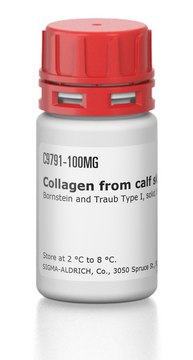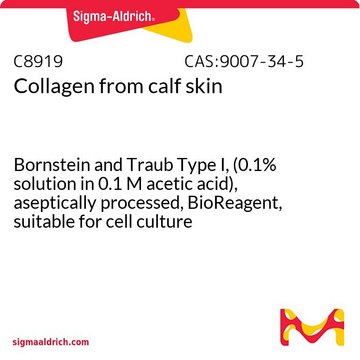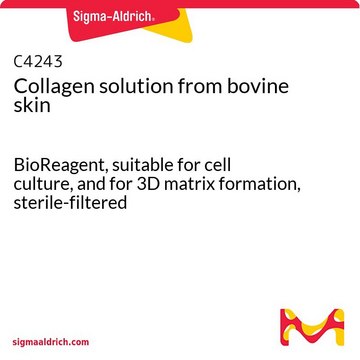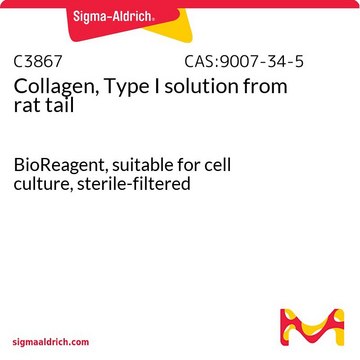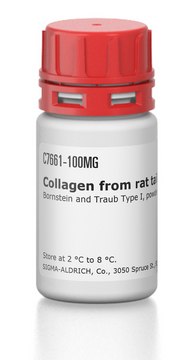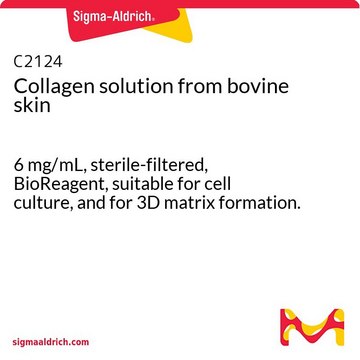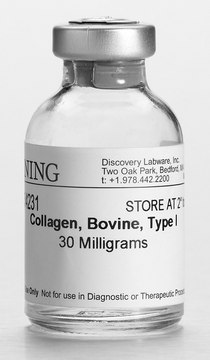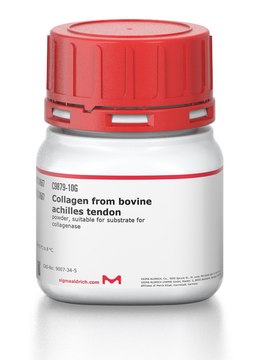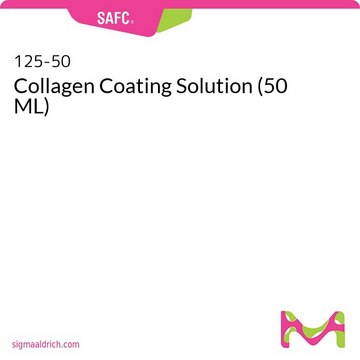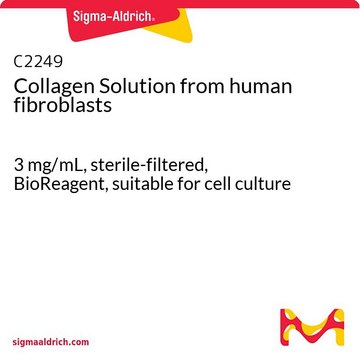L7213
Collagen G
Type 1 from calf skin, 0.4% solution in HCl, 4 mg/mL
Synonym(s):
Collagen Gel, Collagen Solution
Sign Into View Organizational & Contract Pricing
All Photos(1)
About This Item
UNSPSC Code:
12352202
NACRES:
NA.75
Recommended Products
biological source
bovine (calf) skin
form
liquid
packaging
100 mL of
concentration
4 mg/mL
technique(s)
cell culture | mammalian: suitable
shipped in
ambient
storage temp.
2-8°C
General description
This product is identical to Biochrom GmbH part number L 7213. It is comprised of acid-soluble calfskin collagens in a 0.4 % solution containing 15 mmol/l HCl. Collagen G is used in the production of gels, to embed cells. Collagen G gels are suitable for use as a substrate for adherent cells in a cell culture vessel and as a floating matrix in or on cell culture medium.
Preparation Note
Recommendations for optimum gelling with Collagen G
Geling is heavily influenced by the pH value. Before starting work, pre-cool all reagents to a temperature of +2 - +8C.
Solution A:
0.7 M sodium hydroxide and 1 M HEPES buffer are mixed equally (e.g. 5 ml sodium hydroxide with 5 ml HEPES buffer).
Solution B:
A 10x medium (e.g. RPMI 1640) and solution A are mixed equally (e.g. 5 ml medium with 5 ml solution A).
Examining the gel produced under a microscope and taking pictures
If a 35 mm culture dish is filled with 2 ml Collagen G/buffer media mixture (pH approx. 7.2 - 7.8) and incubated, a gel with faint white diffusion is formed, viewed from above. This diffusion appears as a result of crosslinking of the collagen molecules and should not cause any problems when examining under a microscope or taking pictures.
The accumulation of diffusion is proportional to the increase of thickness of the gel, for example if 5-7 ml instead of 2 ml per 10 cm2 Collagen G (35 mm culture vessel) is used. This could make microscopic and photographic analysis difficult.
Geling is heavily influenced by the pH value. Before starting work, pre-cool all reagents to a temperature of +2 - +8C.
Solution A:
0.7 M sodium hydroxide and 1 M HEPES buffer are mixed equally (e.g. 5 ml sodium hydroxide with 5 ml HEPES buffer).
Solution B:
A 10x medium (e.g. RPMI 1640) and solution A are mixed equally (e.g. 5 ml medium with 5 ml solution A).
- The pH of solution B should be between 7.90 and 8.05. It is advisable to check the pH using a suitable measuring method. If the gel should remain sterile, measure the pH of an aliquot previously removed.
- 8.0 ml Collagen G is gently mixed with 2.0 ml of solution B to produce the ready-to-use solution for gelling. This prevents the formation of air bubbles.
- 3.0 ml of solution prepared in this way is pipetted into a 25 cm2 culture flask. For a culture flask with a diameter of 9 cm, 5.0 ml is required. The culture flask is then incubated vibration-free for at least 1 hour or, for optimum stability, 24 hours at +35°C (± 2°C).
Examining the gel produced under a microscope and taking pictures
If a 35 mm culture dish is filled with 2 ml Collagen G/buffer media mixture (pH approx. 7.2 - 7.8) and incubated, a gel with faint white diffusion is formed, viewed from above. This diffusion appears as a result of crosslinking of the collagen molecules and should not cause any problems when examining under a microscope or taking pictures.
The accumulation of diffusion is proportional to the increase of thickness of the gel, for example if 5-7 ml instead of 2 ml per 10 cm2 Collagen G (35 mm culture vessel) is used. This could make microscopic and photographic analysis difficult.
Other Notes
Specifications:
Cell Attachment: Pass
pH: 1.8-2.4
Osmolality: 0.01-0.05 Osm/kg H20
Collagen Content: 0.37-0.45%
Hydroxyproline: 0.046-0.0565%
Color: Colorless
Appearance: Clear
Cell Attachment: Pass
pH: 1.8-2.4
Osmolality: 0.01-0.05 Osm/kg H20
Collagen Content: 0.37-0.45%
Hydroxyproline: 0.046-0.0565%
Color: Colorless
Appearance: Clear
Storage Class Code
12 - Non Combustible Liquids
WGK
nwg
Flash Point(F)
Not applicable
Flash Point(C)
Not applicable
Choose from one of the most recent versions:
Certificates of Analysis (COA)
Lot/Batch Number
Don't see the Right Version?
If you require a particular version, you can look up a specific certificate by the Lot or Batch number.
Already Own This Product?
Find documentation for the products that you have recently purchased in the Document Library.
Our team of scientists has experience in all areas of research including Life Science, Material Science, Chemical Synthesis, Chromatography, Analytical and many others.
Contact Technical Service